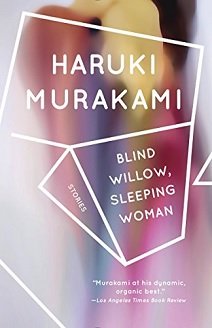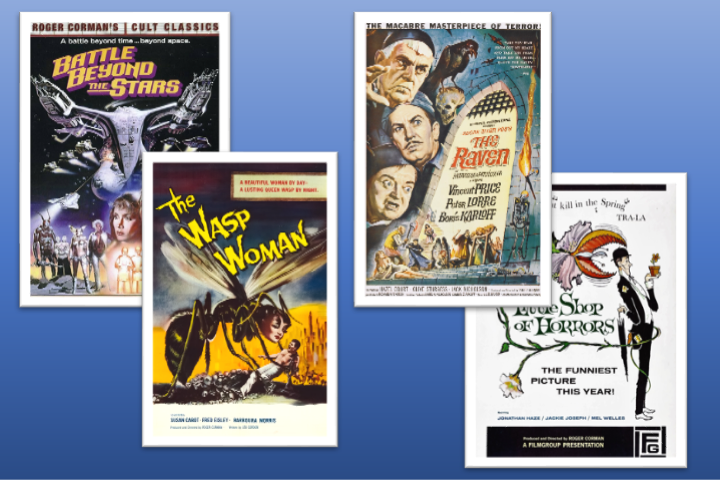Director Pierre Földes on adapting Haruki Murakami to the screen: “The supernatural and the commonplace rub together.”
A look at the magical realism fiction that inspired the movie Blind Willow, Sleeping Woman.
A giant talkative frog, a lost cat, and a tsunami help a bank employee, his wife and a schizophrenic accountant to save Tokyo from an earthquake and find a meaning to their lives. The new animated movie Blind Willow, Sleeping Woman adapts the stories of magical realism author Haruki Murakami.
The film is directed by Pierre Földes, who discovered Murakami when he was living in New York, working freelance as a film score composer. “I was instantly captivated by his style,” Földes says, “where the supernatural and the commonplace rub together. He’s an author who brings a fresh perspective by telling stories about what is happening deep down inside of us by describing only the faint ripples on the surface. When I returned to Europe, I got into animation which I know something about through my father, Peter Földes, an amazing, César-winning animator in his day. I started to develop a feature-length 2D animation project based on Murakami’s work.”
Murakami is hugely popular, Földes says, yet there have been very few adaptations of his work for the big screen. “In New York, his agents immediately tried to put me off—‘He’s a rock star’, they said—arguing that he tended to reject everything and detested animation films. However, he was immediately drawn to the ‘originality’ of my graphic style that I sent to him and my general approach. He invited me to adapt his short stories.”
About the movie
A giant talking frog and an elusive cat help a listless bank employee, his traumatized wife, and a lonely accountant seek meaning in their lives and possibly save Tokyo from catastrophe in the animated feature Blind Willow, Sleeping Woman. Based on stories by acclaimed Japanese author Haruki Murakami (Drive My Car), this feature debut by composer Pierre Földes won the Jury Special Mention award at the renowned Annecy Animation Film Festival and the Grand Prize at the Anima Festival in Brussels.
In Tokyo, not long after the 2011 earthquake, Kyoko suddenly leaves her husband Komura after spending five days glued to the news on TV. Komura takes a week’s leave from work and heads north to deliver a box and its unknown contents to two young women. His colleague Katagiri, a simple debt collector by profession and an awkward loner in life, returns home one evening to find a 7-foot-tall frog asking for his help to save Tokyo from a tsunami. Using an innovative live-action 3D motion capture process, Foldes captures the memories, dreams and visions of these characters as they attempt to rediscover their true selves.
Blind Willow Sleeping Woman (2022) | Official Trailer | Pierre Foldes
From the bestselling author of Kafka on the Shore and The Wind-Up Bird Chronicle comes this superb collection of twenty-four stories that generously expresses Murakami’s mastery of the form. From the surreal to the mundane, these stories exhibit his ability to transform the full range of human experience in ways that are instructive, surprising, and relentlessly entertaining.
Here are animated crows, a criminal monkey, and an iceman, as well as the dreams that shape us and the things we might wish for. Whether during a chance reunion in Italy, a romantic exile in Greece, a holiday in Hawaii, or in the grip of everyday life, Murakami’s characters confront grievous loss, or sexuality, or the glow of a firefly, or the impossible distances between those who ought to be closest of all.
About the author
In 1978, Haruki Murakami—the man who would one day be the award-winning magical realist author—was in a stadium watching a baseball game. One of the batters hit a double—and Murakami suddenly realized that he could write a novel. He went home and began writing that night.
In the years since, he has written novels, essays, and short stories. His bestselling work has been translated into 50 languages and has sold millions of copies around the world. He has received numerous awards for his work, including the Jerusalem Prize, the Franz Kafka Prize, the Frank O’Connor International Short Story Award, and the World Fantasy Award.
His novels include Kafka on the Shore, Norwegian Wood, The Wind-Up Bird Chronicle, 1Q84, Hard-Boiled Wonderland and the End of the World, Killing Commendatore, After Dark, and A Wild Sheep Chase. His short stories have been collected into the books Blind Willow, Sleeping Woman (the basis for the new movie), The Elephant Vanishes, and Men Without Women.
Find more Haruki Murakami online
Related links:
About the director
A consummate artist, Pierre Földes is a director, composer and painter. Born in the United States to a Hungarian father and British mother, Pierre Földes is the son of a pioneer of computer animation, Peter Földes, nominated for an Oscar and a César winner.
Pierre grew up in Paris where he studied piano and composition. He began his career in New York composing music for film and advertising before moving to Europe. Fascinated by drawing and animation, he has written and directed several short films by adapting a production pipeline to his idea of film. He has thus developed his own unique and personal style and technique.
Földes thinks that many of us—at one point or other in our lives—will experience a wake-up call that helps us realize that the path we are on isn’t working out for us, or that the person we have become isn’t who we set out to be. “This may have happened either due to decisions we did or didn’t take,” he says, “or out of sheer laziness. This wake-up call might be a person who comes into our lives, a separation, a sudden event, or simply the fallout from something that happens in our lives.”
In the specific case of this film, it’s an earthquake, the one which triggered a tsunami in March 2011. “The characters are at a standstill in their lives but don’t know it,” Földes says. “They are asleep. A seismic event, both real and internal, opens their eyes to hidden truths.”
The first of the six short stories Földes chose to adapt was “Blind Willow, Sleeping Woman.” Which is why he wanted to keep that as the title for the film.
“It’s also the name of a collection of short stories that is one of his global bestsellers,” Földes says. “I restricted myself to the six short stories that most spoke to me, that went well together, because they appealed to me, excited me, roused all kinds of emotions in me, as subtle as they were indescribable, as profound as they were unexpected, but with no other plan in mind than to use whatever inspired me.”
Földes approached the process of adaptation in steps. “The first step,” he says, “timider and more respectful, consisted of closely following the texts with all the characters they contained. Each story was distinct and followed its course until the end. There were five stories at this stage, including one which was a little absurd that I chopped up and which served as a promenade, a space to breathe between the others, like the Promenades in Mussorgsky’s Pictures at an Exhibition suite.”
As he advanced with the screenplay, Földes felt that the dozen characters could and would have to be distilled into four main protagonists, representing their various facets. “So, I gradually came up with a main storyline in which the structure of each short story was broken up and deconstructed,” he says. “From this second step emerged a screenplay composed of stories completely tangled up with the same characters who featured in all of them.
“The third step entailed creating a structure in seven parts in which the beauty, singularity and rhythm inherent to each story was recreated while the characters who transcended all of the stories lived on in a single continuous thread, a wholly original one this time and whose meaning was still unclear to me at the outset.”
It was only later that he understood what he’d written. “The events that I’d been most touched by had naturally seeped into the story I was telling,” he says, “creating the backbone, the chronology, which had become relatively fragmented and deconstructed in the film’s final narrative.
“These entangled stories tell how a life-changing event comes to be the trigger for an existential wake-up call. The way each story plays out is precisely what I wanted to accomplish with this film. I didn’t want to explain, give a conclusion, spell things out. Thus, at the end of the film, the characters haven’t resolved their problems but have managed to change course, come to a realization. That’s the subject of the film. I want to nourish spectators from the inside, so that once they’ve digested the film, it encourages them to take a look at themselves.
To achieve this, Földes opted for a fairly dark, simple mise en scène using mostly static shots. “It was a deliberate choice for the film to be very light in terms of dialogue,” he says. “The shot/reverse shot technique would have been too off-putting. What emerges is a storyboard with various precise shots in which the reality of the dialogued interactions are often mixed up with what is described, in particular between Frog and Katagiri, when Katagiri imagines what Frog, his alter ego, says to him.”
Földes’ goal was to create an atmosphere, something mysterious that sparks questions at every moment. “The images are constructed for this purpose,” he says. “I’m not trying to describe a reality but rather to transplant it on to a more expressionist vision to highlight what I feel is most important. For me that’s the crux of animation: to interpret the image, the scenery, the movements, but also to simplify them so the spectator can create their own vision of things. So, background figures appear as shadows, either transparent or in colour depending on their importance in the shot. The scenery, which is mostly filled in, is occasionally shown as simple lines.
“Regarding the acting, this was the result of working with the actors in an approach to mise en scène that was closer to theatre than realism. So, we decided beforehand how the actors would act by doing a proper shoot but without lighting or scenery. This technique is different from rotoscoping in the sense that the animator doesn’t trace over the live footage but takes inspiration from the actors, their expressions, rhythm and movements as the basis for the animation. Although the final voices were recorded in post because we wanted a more crafted soundtrack, the voices from the shoot help the animator to embody the characters.
“The ‘promenades’ changed in the current version of the screenplay from how I’d described them above into contemplative moments that match up with the actual numbering of the chapters we see in the film. It’s during these moments, these breathers, that the music combined with the images plays an active role in introducing a new climate while giving the time for the spectator to digest what they’ve just seen.”
Földes studied composing, so he’s fascinated by questions regarding the sound, and he composed the film’s score. “I see sound design as an integral component of the music composition,” he says. “The music is designed first and foremost to create a climate, an ambience rather than to emphasize the emotions already conveyed visually. I wanted the music to heighten the film from a sensory perspective. In addition to the orchestral music, there are electro-acoustic pieces, and, in some scenes, music inspired by Japanese film noir from the 1950s.”
As a director, Földes’ aim is to create an innovative film that tells a subtly magical story in an original way, anchored in a humdrum, everyday world flipped on its head by cataclysmic events both real and internal. “To show this inner life within a world of magical realism,” he says, “I feel animation is the perfect medium, because everything has to be recreated from scratch which produces a shift from reality. This need for a shift and transposition is an essential part of my directorial approach.”
More from Monster Complex
N.D. Jones: Fairy Tale Fatale is an urban fantasy romance series reimagining fairy tales
Complete Kate Daniels Series by Ilona Andrews in Order + Q&A
L.A. Banks: ‘Minion: Vampire Huntress Legend’ #1—the beast is coming for her…
Who WROTE the Vampire Diaries books? Don’t believe the name on the cover…
‘What We Do in the Shadows’ Fans—16 Vampire Books You Should Check Out
Kim Harrison Rachel Morgan | Hollows Series Reading Order + Author Q&A
Related links
Best Movies Based on Haruki Murakami's Books, Ranked (MovieWeb)
5 Best Haruki Murakami Film Adaptations (Japan Web Magazine)
The 15 Best Magical Realism Movies That Mix Fantasy and the Real World (WhatNerd)
7 Best Magic Realism Movies (Game Rant)
10 Best Magical Realism Movies, According To Reddit (Screen Rant)
From 'Being John Malkovich' to 'Birdman': 9 Best Uses of Magical Realism in Film (Collider)
The Best Magic Realism Movies of All Time (Flickchart)
Top Ten Magical Realism Films (Fantasy Magazine)
Urban Fantasy vs. Magical Realism (Cady Hammer)
The 4 Pillars Of Magic Realism (Writers Write)
100 Must Reads Of Magical Realism (Book Riot)
10 Classic Magical Realism Books You Should Read (Mental Floss)
30+ Magical Realism Books to Read Now (Beyond the Bookends)

















Pop music legend Brian Wilson wrote so many amazing songs. But I’m here to talk about “This Isn’t Love”—the song he wrote for the 2000 movie The Flintstones in Viva Rock Vegas.